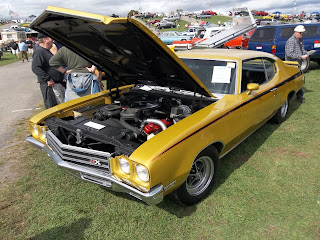1984 was an important year for Buick in many ways. Sales were riding high, many new platforms were in the works with the front wheel drive compact Skyhawk and the mid sized Century being well accepted, the Olympic sponsorship they had been nurturing for over two years was to culminate that summer in the Games of Los Angeles, and they were about to introduce an iconic model that would forever change the public's perception of Buick.
By the early 80s, Buick's V-6 engine had become a mainstay across the line. The 3.8 litre version powered the midsize Regal and a slightly larger version was offered in Riviera, Le Sabre and even Electra. A smooth and durable little engine, it developed 125 horsepower in 4.1 litre trim. But hehind the scenes, Buick engineers were hard at work on the 3.8 litre engine, and in 1984 came out with a 3.8 litre turbocharged engine with sequential fuel injection that produced 200 HP. It was available in Regal and Riviera T-Type coupes and set the stage for one of the most famous Buicks of all time.
The special edition WE2 Grand National package was introduced as a limited edition in the spring of 1984. It came in one color- Black (Code 19) , with a black and grey interior featuring special Lear Siegler buckets seats with leather inserts and Turbo 6 logos. The bumpers and all bright trim were black. There was a front air dam and a black rear spoiler, blacked out wheel opening moldings, black window reveal moldings, black headlamp and taillamp bezels, and even a black standard antenna.
Every piece of trim on the car was black, the only bright being the Grand National fender emblems, the 3.8 SFI Turbo badges on the hood, the header car and edges of the black grille, and the aluminum wheels- and even they featured blacked out paint and black centers. It was Darth Buick, and people went crazy over it. Enthusiast magazines couldn't believe it was a Buick. The era of the modern Buick performance car was here, and it was all powered by Buick's amazing V6 engine, the backbone of the Buick line.
The WE2 was available only on the Regal T-Type (J47) coupe, and the 3.8SFI Turbo and Turbo Hydra Matic Transmission was the only powertrain. Additional options available included Hatch Roof (CC1), Astroroof (CF5), Cruise Control (K34) , Electronic Touch Control Air Conditioning, (C68- regular C60 Air Conditioning was standard), Rear defogger (C49), Remote Trunk Release (A90), Electronic Instrumentation (U52), Theft Deterrent System (UA6) and Lighted Vanity Mirror (D64). Many of these options, especially Hatch Roof and Astroroof were very popular with buyers.
As was the Grand National itself. All told, 2,000 1984 Grand Nationals were shipped to Buick Dealers and the car was a great image vehicle for Buick- with the V-6 at the very heart of it all. It would continue through the 1987 model year and go on to become the stuff of Buick legend.
 |
| Introductory flyer for the 1984 Grand National |
 |
| Page Two of the Introductory Flyer |
 |
| Grand National Fender badge |
 |
| 3.8 SFI Turbo says it all |
 |
| Bad to the Bone |
 |
| B-b-b-b-bad |
 |
| 1984 Grand National seats with leather facings |
 |
| Only 1984 GNs have leather facings |
 |
| 1984-5 Grand national alloy wheels |
One important footnote is the introductory commercial- George Thorogood's "Bad to the Bone", recently used in the movie
Christine, was licensed and adapted to introduce the Grand National. And "Bad to the Bone" became its mantra. Take a look:
Wouldn't you really rather have a B-b-b-b-Buick?


























































